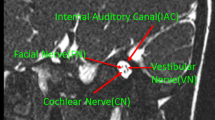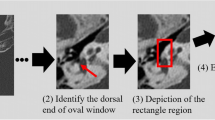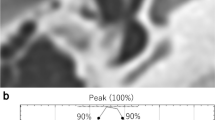Abstract
Objective
Diagnosis of cochlear malformation on temporal bone CT images is often difficult. Our aim was to assess the utility of deep learning analysis in diagnosing cochlear malformation on temporal bone CT images.
Methods
A total of 654 images from 165 temporal bone CTs were divided into the training set (n = 534) and the testing set (n = 120). A target region that includes the area of the cochlear was extracted to create a diagnostic model. 4 models were used: ResNet10, ResNet50, SE-ResNet50, and DenseNet121. The testing data set was subsequently analyzed using these models and by 4 doctors.
Results
The areas under the curve was 0.91, 0.94, 0.93, and 0.73 in ResNet10, ResNet50, SE-ResNet50, and DenseNet121. The accuracy of ResNet10, ResNet50, and SE-ResNet50 is better than chief physician.
Conclusions
Deep learning technique implied a promising prospect for clinical application of artificial intelligence in the diagnosis of cochlear malformation based on CT images.




Similar content being viewed by others
Availability of data and materials
The datasets used and/or analyzed during the current study are available from the corresponding author upon reasonable request.
References
Sennaroglu L, Saatci I. A new classification for cochleovestibular malformations[J]. Laryngoscope. 2002;112:2230–41.
Sennaroglu L, Saatci I. Unpartitioned versus incompletely partitioned cochleae: radiologic differentiation[J]. Otol Neurotol. 2004;25:520–9.
Reefhuis J, Honein MA, Whitney CG, et al. Risk of bacterial meningitis in children with cochlear implants[J]. N Engl J Med. 2003;349:435–45.
Sennaroglu L. Cochlear implantation in inner ear malformations—a review article[J]. Cochlear Implants Int. 2010;11(1):4–41.
Johnson J, Anil KL. Sensorineural and conductive hearing loss associated with lateral semicircular canal malformation[J]. Laryngoscope. 2000;110:1673–9.
Huo L, Wang H. Characteristics and application of inner ear CT in 20 cases of sensorineural hearing loss in children[J]. Acta Otolaryngol. 2012;132(12):1261–5.
Krizhevsky A, Sutskever I, Hinton GE. Imagenet classification with deep convolutional neural networks[J]. Proc Adv Neural Inf Process Syst. 2012;25:1097–105.
Szegedy C, Liu W, Jia Y, et al. Going deeper with convolutions[J]. In: IEEE, 2015, pp 1–9.
He K, Zhang X, Ren S, et al. Deep residual learning for image recognition[M]. IEEE Conf Comput Vis Pattern Recognit (CVPR). 2016;2016:770–8.
Shin HC, Roth HR, Gao M, et al. Deep convolutional neural networks for computer-aided detection: CNN architectures, dataset characteristics and transfer learning[J]. IEEE Trans Med Imaging. 2016;35(5):1285–98.
Al-Masni MA, Al-Antari MA, Park JM, et al. Simultaneous detection and classification of breast masses in digital mammograms via a deep learning YOLO-based CAD system[J]. Comput Methods Programs Biomed. 2018;157:85–94.
Hsieh KL, Lo CM, Hsiao CJ. Computer-aided grading of gliomas based on local and global MRI features[J]. Comput Methods Programs Biomed. 2017;139:31–8.
Sennaroglu L, Bajin MD. Classification and current management of inner ear malformations[J]. Balkan Med J. 2017;34(5):397–411.
He K, Zhang X, Ren S, Sun J. Deep residual learning for image recognition [M]. In: Proceedings of the IEEE conference on computer vision and pattern recognition. Las Vegas, USA. 2016, pp 770–778.
Hu J, Shen L, Albanie S, et al. Squeeze-and-excitation networks[J]. IEEE Trans Pattern Anal Mach Intell. 2020;42(8):2011–23.
Huang G, Liu Z, Van Der Maaten L, et al. Densely connected convolutional networks[M]. IEEE Conf Comput Vis Pattern Recognit (CVPR). 2017;2017:2261–9.
Mafong DD, Shin JE. Use of laboratory evaluation and radiologic imaging in the diagnostic evaluation of children with sensorineural hearing loss [J]. Laryngoscope. 2002;112:1–7.
Adunka O, Kiefer J. Impact of electrode insertion depth on intracochlear trauma [J]. Otolaryngol Head Neck Surg. 2006;135(3):374–82.
Cha D, Pae C, Seong SB, et al. Automated diagnosis of ear disease using ensemble deep learning with a big otoendoscopy image database [J]. EBioMedicine. 2019;45:606–14.
Hallac RR, Lee J, Pressler M, et al. Identifying ear abnormality from 2D photographs using convolutional neural networks [J]. Sci Rep. 2019;9(1):18198.
Miwa T, Minoda R, Yamaguchi T, et al. Application of artificial intelligence using a convolutional neural network for detecting cholesteatoma in endoscopic enhanced images[J]. Auris Nasus Larynx. 2021;49:11–7.
Fujima N, Andreu-Arasa VC, Onoue K, et al. Utility of deep learning for the diagnosis of otosclerosis on temporal bone CT. Eur Radiol. 2021;31(7):5206–11.
Wang YM, Li Y, Cheng YS, et al. Deep learning in automated region proposal and diagnosis of chronic otitis media based on computed tomography. Ear Hear. 2020;41(3):669–77.
Byun H, Park CJ, Oh SJ, et al. Automatic prediction of conductive hearing loss using video pneumatic otoscopy and deep learning algorithm. Ear Hear. 2022;43:1–11.
Eroglu O, Eroglu Y, Yildirim M, et al. Is it useful to use computerized tomography image-based artificial intelligence modelling in the differential diagnosis of chronic otitis media with and without cholesteatoma?[J]. Am J Otolaryngol. 2022;43:103395.
Takahashi M, Noda K, Yoshida K, et al. Preoperative prediction by artificial intelligence for mastoid extension in pars flaccida cholesteatoma using temporal bone high-resolution computed tomography: a retrospective study[J]. PLoS ONE. 2022;17(10):e0273915.
Acknowledgements
We thank the members of our research groups for providing technical Assistance and participating in discussions.
Funding
This research was supported by Grants from Natural Science Foundation of Hunan Province (No. 2033JJ60302).
Author information
Authors and Affiliations
Contributions
ZL wrote the main manuscript text; ST, BL, YX manually segmented important structures in the temporal bone; LZ performed the experiments; ZL, ST analyzed the data; AT designed research. All authors read and approved the final manuscript.
Corresponding author
Ethics declarations
Conflict of interest
The authors declare that there are no conflicts of interest regarding the publication of this article.
Ethical statement
This study was approved by The First Affiliated Hospital of Guangxi Medical University Medical Ethics Committee with Grant No. 2022-KY-E-(135).
Consent for publication
Not applicable.
Additional information
Publisher's Note
Springer Nature remains neutral with regard to jurisdictional claims in published maps and institutional affiliations.
About this article
Cite this article
Li, Z., Zhou, L., bin, X. et al. Utility of deep learning for the diagnosis of cochlear malformation on temporal bone CT. Jpn J Radiol 42, 261–267 (2024). https://doi.org/10.1007/s11604-023-01494-z
Received:
Accepted:
Published:
Issue Date:
DOI: https://doi.org/10.1007/s11604-023-01494-z




